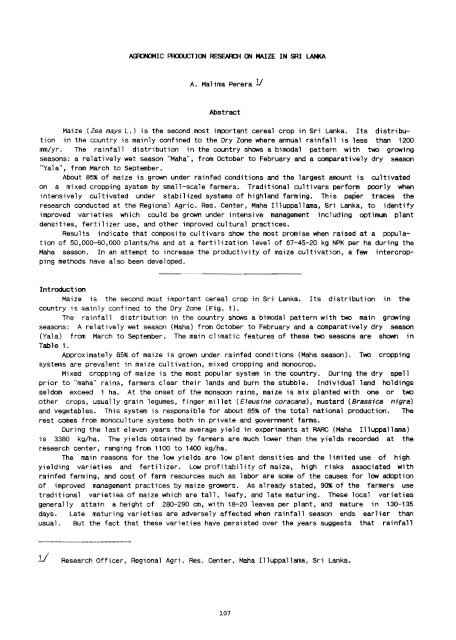Proceedings of the Fifth Asian Regional Maize Workshop - Search ...
Proceedings of the Fifth Asian Regional Maize Workshop - Search ...
Proceedings of the Fifth Asian Regional Maize Workshop - Search ...
Create successful ePaper yourself
Turn your PDF publications into a flip-book with our unique Google optimized e-Paper software.
AGOOtOolIC PRJ(X£TION RESEAOCH ON MAIZE IN SRI LANKA<br />
A. Malima Perera 11<br />
Abstract<br />
<strong>Maize</strong> (Zea mays L.) is <strong>the</strong> second most important cereal crop in Sri Lanka. Its distribution<br />
in <strong>the</strong> country is mainly confined to <strong>the</strong> Dry Zone where annual rainfall is less than 1200<br />
mm/yr. The rainfall distribution in <strong>the</strong> country shows a bimodal pattern with two growing<br />
seasons: a relatively wet season "Maha", from OCtober to February and a comparatively dry season<br />
"Yala", from March to September.<br />
About 85% <strong>of</strong> maize is grown under rainfed conditions and <strong>the</strong> largest amount is cultivated<br />
on a mixed cropping system by small-scale farmers. Traditional cultivars perform poorly when<br />
intensively cultivated under stabilized systems <strong>of</strong> highland farming. This paPer traces <strong>the</strong><br />
research conducted at <strong>the</strong> <strong>Regional</strong> Agric. Res. Center, Maha Illuppallama, Sri Lanka, to identify<br />
improved varieties which could be grown under intensive management including optimum plant<br />
densities, fertilizer use, and o<strong>the</strong>r improved cultural practices.<br />
Results indicate that composite cultivars show <strong>the</strong> most promise when raised at a population<br />
<strong>of</strong> 50,000-60,000 plants/ha and at a fertilization level <strong>of</strong> 67-45-20 kg NPK per ha during <strong>the</strong><br />
Maha season. In an attempt to increase <strong>the</strong> productivity <strong>of</strong> maize cultivation, a few intercropping<br />
methods have also been developed.<br />
Introduction<br />
<strong>Maize</strong> is <strong>the</strong> second most important cereal crop in Sri Lanka. Its distribution in <strong>the</strong><br />
country is mainly confined to <strong>the</strong> Dry Zone (Fig. 1).<br />
The rainfall distribution in <strong>the</strong> country shows a bimodal pattern with two main growing<br />
seasons: A relatively wet season (Maha) from October to February and a comparatively dry season<br />
(Yala) from March to September. The main climatic features <strong>of</strong> <strong>the</strong>se two seasons are shown in<br />
Table 1.<br />
Approximately 85% <strong>of</strong> maize is grown under rainfed conditions (Maha season). Two cropping<br />
systems are prevalent in maize cultivation, mixed cropping and monocrop.<br />
Mixed cropping <strong>of</strong> maize is <strong>the</strong> most popular system in <strong>the</strong> country. During <strong>the</strong> dry spell<br />
prior to "maha" rains, farmers clear <strong>the</strong>i r lands and burn <strong>the</strong> stubble. Individual land holdings<br />
seldom exceed 1 ha. At <strong>the</strong> onset <strong>of</strong> <strong>the</strong> monsoon rains, maize is mix planted with one or two<br />
o<strong>the</strong>r crops, usually grain legumes, finger millet (E7eusine coracana), mustard (Brassica nigra)<br />
and vegetables. This system is responsible for about 85% <strong>of</strong> <strong>the</strong> total national production. The<br />
rest comes from monoculture systems both in private and government farms.<br />
During <strong>the</strong> last eleven years <strong>the</strong> average yield in experiments at RARe (Maha 11 1uppal lama)<br />
is 3380 kg/ha. The yields obtained by farmers are much lower than <strong>the</strong> yields recorded at <strong>the</strong><br />
research center, ranging from 1100 to 1400 kg/ha.<br />
The main reasons for <strong>the</strong> low yields are low plant densities and <strong>the</strong> limited use <strong>of</strong> high<br />
yielding varieties and fertilizer. Low pr<strong>of</strong>itability <strong>of</strong> maize, high risks associated with<br />
rainfed farming, and cost <strong>of</strong> farm resources such as labor are some <strong>of</strong> <strong>the</strong> causes for low adoption<br />
<strong>of</strong> improved management practices by maize growers. As already stated, 90% <strong>of</strong> <strong>the</strong> farmers use<br />
traditional varieties <strong>of</strong> maize which are tall', leafy, and late maturing. These local varieties<br />
generally attain a height <strong>of</strong> 280-290 cm, with 18-20 leaves per plant, and mature in 130-135<br />
days. Late maturing varieties are adversely affected when rainfall season ends earlier than<br />
usual. But <strong>the</strong> fact that <strong>the</strong>se varieties have persisted over <strong>the</strong> years suggests that rainfall<br />
1.1 Research Officer, <strong>Regional</strong> Agri. Res. Center, Maha Illuppallama, Sri Lanka.<br />
107

















